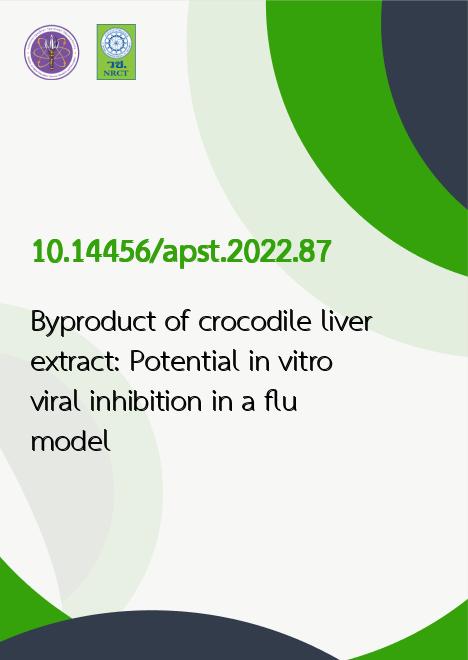
|
Byproduct of crocodile liver extract: Potential in vitro viral inhibition in a flu model |
|---|---|
| รหัสดีโอไอ | |
| Creator | Jureerut Daduang |
| Title | Byproduct of crocodile liver extract: Potential in vitro viral inhibition in a flu model |
| Contributor | Thanannat Meemark, Sakda Daduang, Pornsuda Maraming, Patcharaporn Tippayawat |
| Publisher | Asia-Pacific Journal of Science and Technology |
| Publication Year | 2565 |
| Journal Title | Asia-Pacific Journal of Science and Technology |
| Journal Vol. | 27 |
| Journal No. | 6 |
| Page no. | 12 |
| Keyword | Animal Byproduct, Antiviral Agents, Crocodile, Influenza A Virus, Liver Compounds |
| URL Website | https://www.tci-thaijo.org/index.php/APST |
| Website title | https://so01.tci-thaijo.org/index.php/APST/article/view/262325 |
| ISSN | 2539-6293 |
| Abstract | Crocodile organs have been used in traditional medicines for the purpose of disease reduction. However, these claims have not been rigorously studied. This study aimed to explore the potential of crude extract from the liver of Crocodylus siamensis (CLE) against influenza virus. The toxicity concentration (CC50) of CLE was assayed by a colorimetric assay for cellular metabolic activity (MTT) and was found to be 32.0 mg/mL, and the concentration reducing replication (EC50) of influenza A (H3N2/Vic) evaluated by a viral titration technique for A549 cells was 0.039 mg/mL. The selectivity index (SI), which is the ratio between cytotoxicity and antiviral activity, was 818. A time-of-addition assay was used to identify which step(s) of the viral propagation chain was blocked by CLE. The expression of immune-related genes was tested by RT-PCR to observe the possible mechanisms of antiviral activity. The antiviral activity of CLE on multiple cycles of viral replication was assessed by the viral titration technique. CLE pretreatment of cells resulted in higher viral inhibition. The mRNA expression levels of the immune-related genes MxA, IL-2, CCL5/RANTES, and CXCL10/IP-10 were significantly different in the CLE-treated group. We found that CLE inhibited the propagation of influenza A (H3N2/Vic). This study is a starting point to investigate the scientific analysis of crocodile byproducts. |